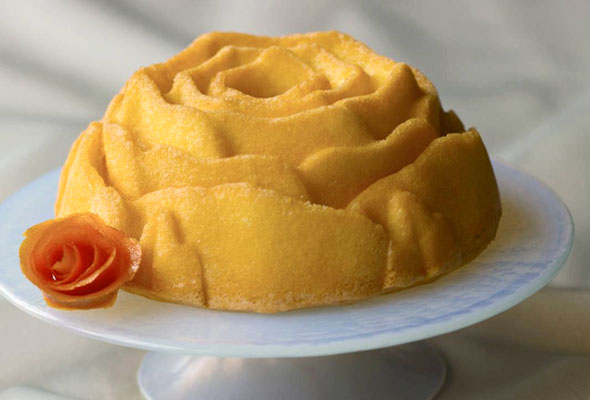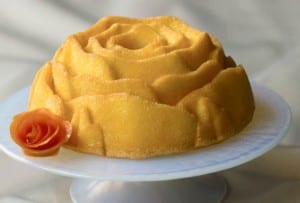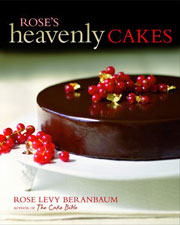
It was exciting to discover that this moist and gossamer cornerstone of French cake baking can be made in a decorative mold. And the beauty of it is that it demonstrates that the cake is delicious enough to stand alone without the further adornment of frosting. For this cake, I prefer to use cake flour or all-purpose flour with cornstarch for the highest possible rise. If you don’t have a rose pan, any Bundt or tube pan will work. For the best flavor, complete the cake a day ahead to let the flavors meld.–Rose Levy Beranbaum
LC The Cake Whisperer Note
Curious to learn even more cake-minded tips and tricks from cookbook author Rose Levy Beranbaum, who we consider to be the cake whisperer? Settle in and watch this video for a spell. We promise, you’ll never again confuse génoise with ganache. And you’ll glean far, far more savvy advice than just that.

Grand Marnier Génoise Cake
Equipment
- One 10-cup metal rose tube pan (or other shape tube pan)
Ingredients
For the cake
- Vegetable spray with flour
- 1/4 cup clarified butter, preferably beurre noisette (see Note)
- 1 teaspoon vanilla extract
- 5 large eggs
- 1/2 cup plus 2 tablespoons superfine sugar, (or just blitz granulated sugar in a blender until finely ground but not powdery)
- 1/2 cup plus 1 tablespoon cake flour or bleached all-purpose flour, sifted into the cup and leveled off
- 1/2 cup cornstarch
For the boozy syrup
- 1/3 cup granulated sugar
- 2/3 cup water
- 3 tablespoons Grand Marnier or Triple Sec
Instructions
Make the cake
- Set an oven rack in the lower third of the oven. Preheat the oven to 350°F (175°C). If using a dark pan, preheat the oven to 325°F (160°C). Coat the pan with baking spray with flour.
- In a saucepan over low heat, warm the butter until almost hot (110° to 120°F or 40° to 50°C). Remove from the heat, stir in the vanilla, and cover to keep warm.
- In the bowl of a stand mixer, lightly combine the eggs and sugar with a long-handled wire whisk. Place the bowl over a pan of simmering water and heat, whisking constantly to prevent curdling, just until the mixture is lukewarm to the touch. Remove from the heat.
- Attach the whisk beater to the mixer and beat the egg mixture on high speed until the mixture becomes very thick and airy and more than quadruples in volume, a minimum of 5 minutes. (If using a hand-held mixer, this will take you at least 10 minutes.)
- Sift together the flour and cornstarch. Remove a little less than 1 cup of the beaten egg mixture from the mixer bowl and whisk it into the melted butter until thoroughly combined. Set aside.
- Sift about half of the flour mixture over the remaining egg mixture in the mixer and, with a large balloon whisk, slotted skimmer, or silicone spatula, fold the mixtures gently but rapidly until almost all the flour has disappeared. Repeat with the remaining flour mixture until all trace of flour has disappeared.
- Gently fold the warm butter mixture into the flour mixture just until incorporated, being sure to reach to the bottom of the bowl. Immediately and gently pour the batter into the prepared pan and smooth the surface evenly with a small metal spatula. If you’ve beaten the batter long enough, the pan will be a little more than half full.
- Bake for 20 to 30 minutes, or until the cake is golden brown and starts to shrink slightly from the sides of the pan. It will rise in the center to a little above the sides of the pan and then sink slightly when fully baked. Avoid opening the oven door before the minimum baking time or you may cause this fragile cake could fall. To check for doneness, toward the end of the baking time open the oven door just a crack. If the cake doesn’t appear to be done, continue to bake for another 5 minutes.
- Have ready a small metal spatula and a wire rack that has been coated lightly with nonstick cooking spray. The genoise must be unmolded while still hot, as soon as it comes out of the oven, to prevent its collapse. Immediately loosen the top edges of the cake with the small metal spatula and unmold the cake onto the wire rack. Cool completely.
Make the boozy syrup
- In a small saucepan with a tight-fitting lid, stir together the sugar and water until all the sugar is moistened. Bring the mixture to a rolling boil, stirring constantly. Immediately cover and remove from the heat. Let cool completely. Transfer the syrup to a measuring cup with a spout and stir in the alcohol. If necessary, add enough water to equal 1 cup.
Intoxicate the cake
- Using a removable tart pan bottom or two large pancake turners, carefully lift the cooled genoise onto a serving plate. Slip a few strips of wax paper or parchment around the edge of the cake all the way around to prevent drips on the serving plate. Brush the entire surface of the cake with the syrup. Remove the paper. If you can possible wait a day, cover the cake loosely with plastic wrap that has been coated lightly with nonstick cooking spray or a cake dome, if you still have one, and let the syrup work its wonders on the cake overnight.
Notes
How To Make Beurre Noisette
To make beurre noisette, you first need to clarify butter. Heat 6 tablespoons (3 ounces) unsalted butter in a small heavy saucepan over very low heat, watching carefully to prevent burning. (You may need to move any foam on the surface aside to check the progress.) For clarified butter, remove the pan from the heat when the liquid on top is clear and the white solids are resting on the bottom. For beurre noisette, keep the butter on the heat until the milk solids turn a deep brown. For either method, immediately pour the butter through a fine-mesh strainer or a strainer lined with cheesecloth into a heatproof cup.
Explore More with AI
Nutrition
Nutrition information is automatically calculated, so should only be used as an approximation.










How/out of what material is the rose garnish made in your photo? Thanks very much.
Hello, Wayne. I believe that was made by using a vegetable peeler to remove long strips from an orange or, perhaps, a pink grapefruit. The strips were then rolled on themselves and probably held together by a toothpick or two.
Thanks very much. Figured it was a peeling of some sort, but couldn’t tell what kind from the pink color. Grapefruit is probably a good call. Thanks again.
You’re welcome, Wayne.